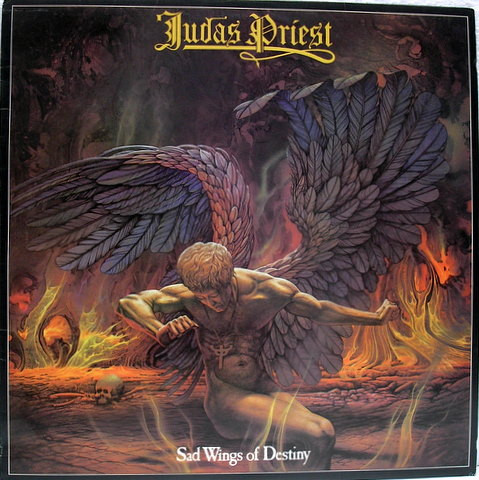„Genocide“ is one of the darkest and most intense tracks from Judas Priest’s 1976 album Sad Wings of Destiny. The song delivers a harrowing narrative of mass slaughter and oppression, making it one of the band’s most politically and socially charged early works. It captures a dystopian vision of suffering, reflecting themes of persecution, destruction, and resistance against overwhelming force.
Overview
At its core, Genocide explores:
- The systematic eradication of a people, with imagery that suggests warfare, oppression, and destruction.
- The helplessness of the victims, who are being pursued and exterminated.
- The looming presence of an unstoppable force, represented as a conquering power or a tyrannical regime.
- A grim sense of inevitability, where the destruction unfolds mercilessly with no hope of escape.
Musically, the song features haunting guitar work, relentless rhythms, and Halford’s chilling vocal delivery, which conveys a mix of despair, urgency, and rage.
Narrative Structure & Themes
1. Introduction: The Hunt Begins
- The song opens with a tense, ominous mood, as the victims realize they are being pursued:
“Mercenary battalions, are poised to strike us down”
- The mercenaries symbolize a military force or an invading power that is hunting down the victims.
- “Poised to strike us down” immediately creates a sense of impending doom.
- Themes: Imminent destruction, war, persecution.
2. The Chaos and Slaughter (Verses)
- The following verses paint a picture of massacre and devastation:
“Dogs of war are helpless, not so the jackals of the street”
- The “dogs of war” may symbolize soldiers or defenders who are powerless to stop the slaughter, while the “jackals of the street” suggest those who profit from the destruction.
- The song depicts genocide as both a military operation and a social breakdown, where even the streets are dangerous.
“Chase the demons’ lightning, across the iron fields”
- “Demons’ lightning” could symbolize gunfire, explosions, or artillery strikes, making the battlefield an apocalyptic war zone.
- Themes: Helplessness, overwhelming force, death and destruction.
3. The Inescapable Fate (Chorus and Middle Section)
- The chorus is a cry of despair:
“Genocide, genocide”
- The repetition of the word hammers in the horror—this is not just war, but the systematic extermination of a people.
“They are gone, nothing left but a memory”
- This stark line emphasizes the finality of genocide—entire groups wiped out, leaving only ghosts in history.
- The lack of resistance further reinforces the song’s tragic inevitability.
- Themes: Eradication, helplessness, historical loss.
4. The Perspective of the Oppressed (Later Verses)
- The song shifts slightly to showcase the victims’ perspective:
“Cries for help unanswered, only echoes from the past”
- A sense of abandonment—the victims have pleaded for help, but no one came.
- The “echoes from the past” could refer to previous genocides, suggesting that history keeps repeating itself.
“The shadow of the reaper will be standing by your side”
- The Grim Reaper’s presence confirms that death is unavoidable.
- There is no escape, no savior—only the certainty of destruction.
- Themes: Death as an inevitability, historical repetition, suffering in silence.
Themes & Symbolism
1. The Horror of Systematic Extermination
- Genocide does not merely describe a battle or war—it conveys the horror of complete annihilation.
- The mercenaries and jackals represent faceless, inhuman forces carrying out this destruction without remorse.
2. The Helplessness of the Oppressed
- Unlike other Judas Priest songs that feature heroic resistance or rebellion, Genocide portrays a hopeless situation where the victims cannot fight back.
- There is no triumphant uprising—only extinction.
3. The Cyclical Nature of History
- The line “only echoes from the past” suggests that history is doomed to repeat itself, warning that genocide is not a singular event, but something humanity has witnessed before and will witness again.
4. The Cold, Unstoppable March of Death
- The mention of the Grim Reaper in the song signifies the inevitability of destruction.
- Unlike fantasy-themed metal, this song keeps its horror grounded in historical and real-world brutality.
Musical & Emotional Impact
1. Foreboding Guitar Work
- The song begins with slow, eerie guitar work, creating a mood of tension and dread.
- As the song progresses, the riffs become heavier and more aggressive, mirroring the increasing intensity of the destruction.
2. Halford’s Haunting Vocals
- His delivery ranges from mournful cries to aggressive declarations, reflecting the dual emotions of fear and fury.
3. The Unrelenting March of Doom
- The song’s mid-tempo rhythm evokes a sense of inevitability, like an unstoppable force moving forward—a fitting musical metaphor for genocide itself.
Legacy & Influence
- Genocide remains one of Judas Priest’s most politically charged songs, standing apart from their usual themes of fantasy, rebellion, and personal struggle.
- Its bleak, realistic depiction of mass slaughter was groundbreaking for the time, influencing later bands that explored themes of war and oppression.
- The song laid the foundation for darker themes in metal, paving the way for thrash, doom, and black metal bands that would later explore similar topics.
Final Verdict
„Genocide“ is one of Judas Priest’s most haunting and thought-provoking songs, delivering a chilling narrative of mass extermination with no hope of salvation. Through its bleak lyrics, intense musical composition, and despair-filled vocal performance, the song paints a vivid picture of destruction and loss, ensuring that its message of historical horror remains unforgettable.
A dark, relentless masterpiece, Genocide stands as a stark warning about the nature of human cruelty and the tragic cycles of history—a theme that remains relevant even today.



